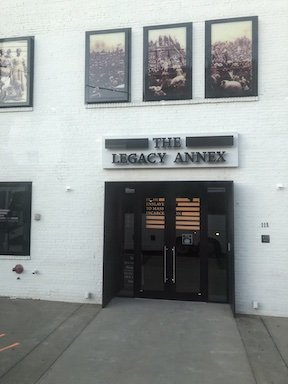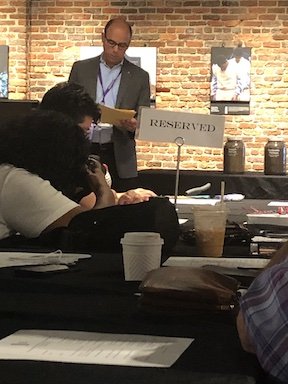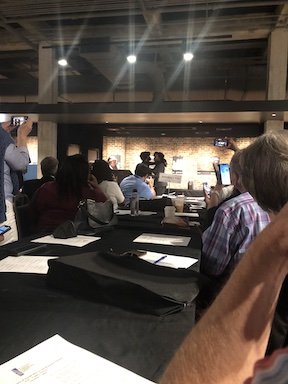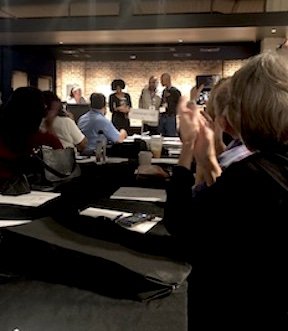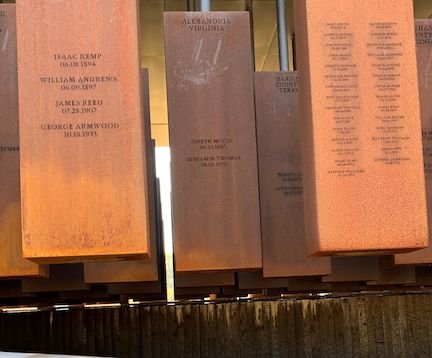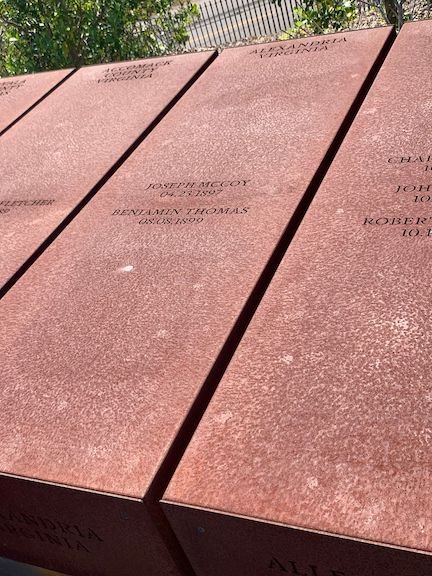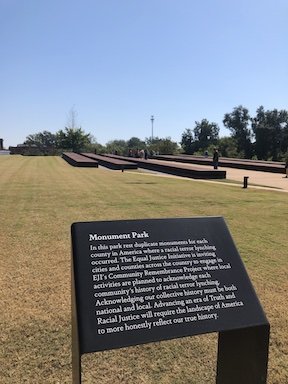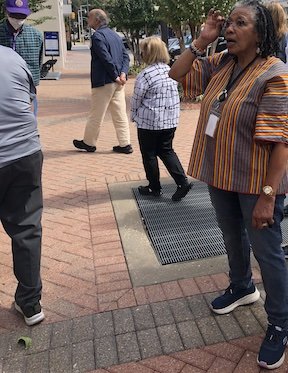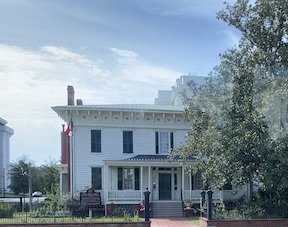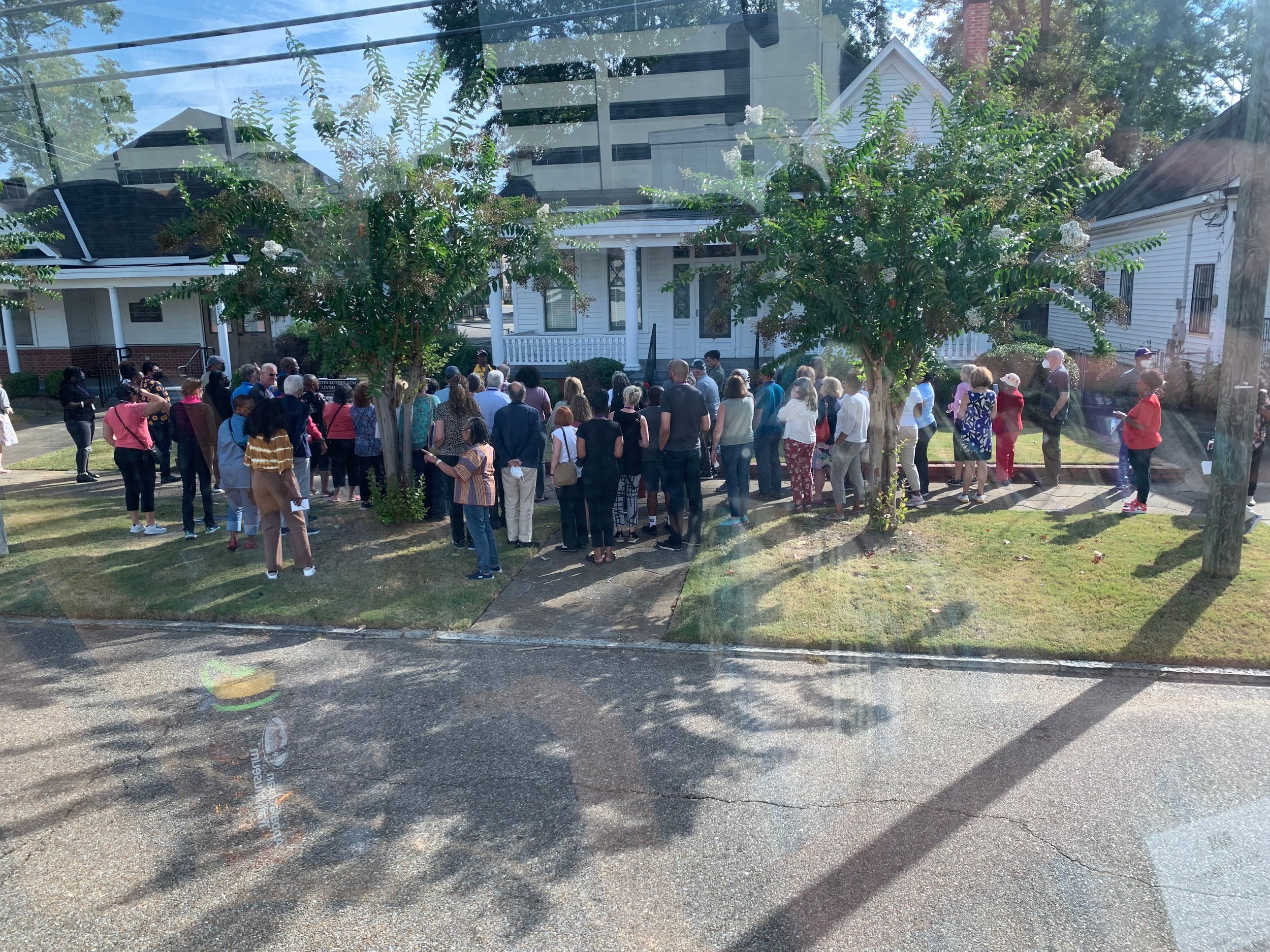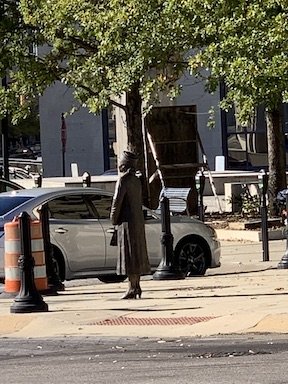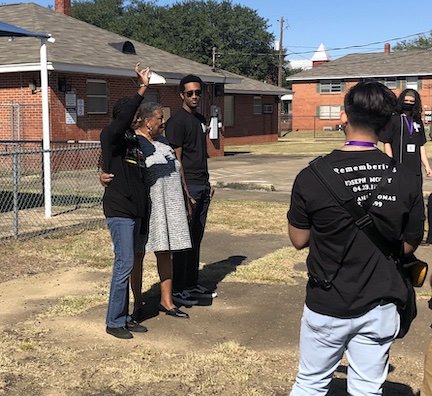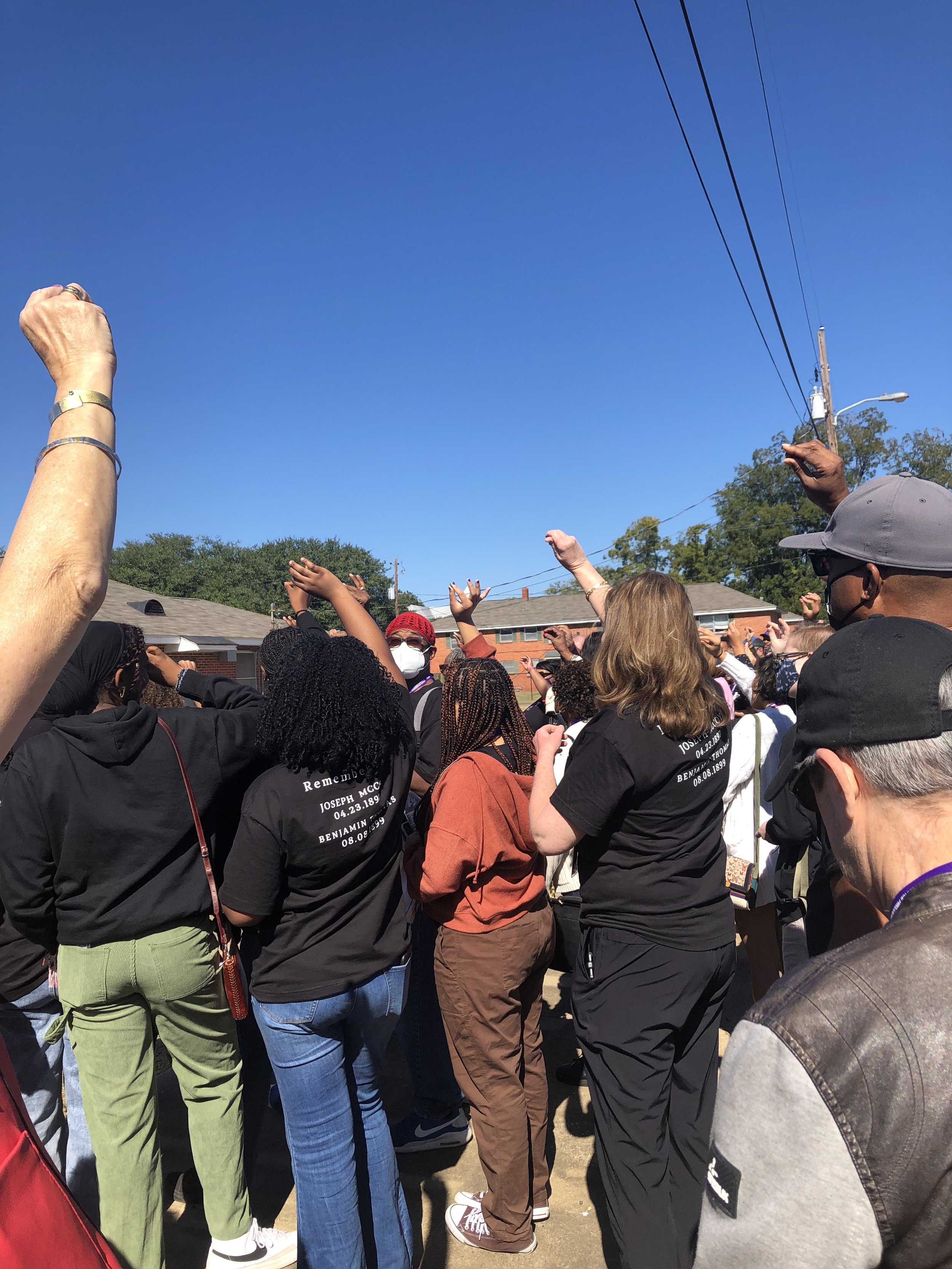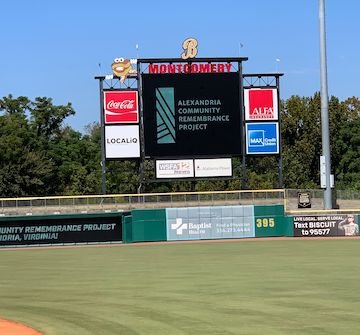Pilgrimage to Montgomery with the Alexandria Community Remembrance Project
/A few impressions among many. First, the pillar—a 6-foot rust-colored steel monument hanging amidst 800 others at the National Memorial for Peace and Justice—inscribed with the name of my city of Alexandria, Virginia, and two names and dates: Joseph McCoy, April 23, 1897, and Benjamin Thomas, August 8, 1899. Second, the Greyhound bus terminal on Court Street in downtown Montgomery, where a violent White mob awaited the arrival of a Freedom Ride bus on May 20, 1961. And this: Two sisters from Selma who shared their childhood memories when they walked with the adults across the Edmund Pettus Bridge on what became known as Bloody Sunday, March 7, 1965.
As expressed by Maya Angelou: “History, despite its wrenching pain, cannot be unlived; however, if faced with courage, need not be lived again.”
At the National Memorial for Peace and Justice, a monument commemorating the lynching of two men from Alexandria hangs amidst about 800 others.
The Alexandria Community Remembrance Project (ACRP) organized a trip to Montgomery, October 6 to 10, 2022. My husband and I joined the group of 150 people, the largest majority of whom were Black and White, and of all ages, religions, and ethnicities. It was not always comfortable but a powerful way to see, hear, and touch these places and events.
Below are some of my own experiences and observations, a White Jewish woman in her 60s who grew up in Connecticut, recognizing that each participant has their own reactions to share with the world, with a few trusted people, or with no one else at all.
[NOTE: To write this post, I turned to a guideline from the Center for the Study of Social Policy to capitalize “Black” and “White.” Also, excellent photographers joined us; the photos here are ours, taken with our phones and often in the back of the room, without good lighting, etc. I hope they present some idea of what we saw. ACRP will be posting photos.]
The Purpose of the Pilgrimage
The Alexandria Community Remembrance Project began about three years ago in connection with a national project developed by the Equal Justice Initiative (EJI), headquartered in Montgomery. From the website: “EJI collaborates with communities to memorialize documented victims of racial violence and foster meaningful dialogue about race and justice.” One way to do this is to recognize the more than 4,400 documented lynchings that took place in at least 12 states from 1877 to 1950. (Note the word “documented”; undoubtedly, many more occurred.)
It was somewhat known, if not widely acknowledged, that Alexandria shares the dubious distinction of being one of these places. Now, their names and circumstances are uncovered. ACRP members researched the lives of the two teens—Joseph McCoy and Benjamin Thomas, ages 18 and 17--and the incidents before, during, and after their murders. In brief, Joseph McCoy and Benjamin Thomas were Black males accused of assault of White young females. McCoy worked for the father of the first girl; Thomas lived next door to the family of the second. In both cases, immediately after the accusation and before trials were held, McCoy and Thomas were sitting in the city jail when mobs dragged them out. “Law enforcement” officials took no meaningful steps to avert what became, in the context of hundreds of fired-up White supremacists, an inevitable climax. More detail about them is on the ACRP site. But it is important to say that Joseph McCoy and Benjamin Thomas suffered violent, sadistic, drawn-out deaths, witnessed and cheered on by hundreds of White onlookers. Blacks who tried to stop Thomas’s lynching were arrested for disturbing the peace.
Transferring the Soil
One step of the Remembrance process is to collect soil from places of meaning to the victim, convene the community to place the soil in a special jar, and present the jar to EJI.
Soil was collected from 21 relevant churches, neighborhoods, and other places . At a ceremony in late September in Alexandria, the soil was placed into two jars in the same shape and labels as others already brought to EJI.
Soil being placed in jars on September 24, 2022. Besides the jars going to EJI, duplicates will remain in Alexandria.
Our bus left Alexandria at 7 am on October 6. The jars went with us. When we arrived at the hotel—after 14 hours down I-95 to I-85—we wanted to clamor out and get to our rooms. Fortunately, one of the steering committee members was wiser. He asked us to disembark and form two lines of honor. He brought the soil jars inside, then we got our suitcases and dispersed for the night.
McArthur Myers carries in the soil jars, the night before transfer to EJI.
Next morning, we went a few blocks to the Legacy Annex for the Remembrance ceremony. Since this whole process began, three descendants of Joseph McCoy were identified. On behalf of the family, Debra White spoke and presented his jar to Emily Wilson from EJI. On behalf of Benjamin Thomas, the pastor of Shiloh Baptist Church, where Thomas was baptized, and two members of the steering committee made the presentation.
ACRP continues to try to locate descendants. Given their young ages at their deaths, they had no chance to create their own families, thus no direct descendants.
Below, L to R: Legacy Annex, Mayor Justin Wilson reads city proclamation with the soil jars behind him, EJI’s Emily Wilson and McCoy descendent Debra White, and Emily Wilson with ACRP members Michael Johnson and McArthur Myers.
Memorial Monuments
The National Memorial opened in 2018. The monuments are displayed alphabetically by place. Sculptures, gardens, and other features also grace the six-acre site. The mood is hushed.
The monuments list names and dates. A few things stood out as I walked among them: most are male, but women and '“unknown” are also inscribed. In some counties, as many as five people were lynched the same day. Most took place around the turn of the century, but even during World War I and World War II, White mobs found the time to organize lynching.
Alexandria’s pillar is in an interior row in the center (thus dark in this image). The white chalky markings are on the original. The Pillar to the right lists the 28 reported lynchings in Maryland.
Around the sides of the Memorial are some of the back stories behind the names. Most were lynched after a purported assault of a White person-not only violent but also making what was deemed an improper comment. Others protested unfair business practices, defended themselves, or tried to register to vote. Hundreds or thousands of White people gleefully witnessed the torture. An EJI publication provides more specifics.
Duplicate pillars are stacked out in the sun to someday go to the places they commemorate. EJI has not yet worked out the process to “return” these pillars.
Legacy Museum
EJI focuses on uncovering the past to understand the present—including the disproportionate incarceration and punishment of people of color, mostly Black men. In that vein, note the “tagline” on the building front of the museum that opened in 2021: From Enslavement to Mass Incarceration.
The museum (photos not allowed inside) uses words, images, and sound to describe the trans-Atlantic and domestic slave trades (Alexandria was one of the largest slave-trading centers in the country), the failed potential of Reconstruction after legal emancipation, use of Jim Crow laws and practices even when declared illegal, and incarceration and current-day conditions. (When we were there, Alabama prisoners were staging a work stoppage in part to protest unhealthy and dangerous conditions and the Supreme Court will rule on a case involving fair voting in the state.)
An example was a test required by Black people trying to register to vote in many states with questions like this:
What does a Writ of Certiorari, Writ of Error Coram Nobis, and Subpoena Duces Tecum mean?
Just in case you had studied and knew the answer, figure out how to respond to this question:
How many jelly beans are in the jar in front if you?
Not to mention poll taxes, threats of violence, and other active measures of voter suppression. Side note: Obviously, in concerns about voting rights today, no one has to guess the number of jelly beans in a jar. Tactics such as reduced polling hours, gerrymandered districts, IDs that must match down to the letter, and difficult access to register or to cast a ballot can also do the trick.
Montgomery: “Birthplace of the Civil Rights Movement, Cradle of the Confederacy”
This odd juxtaposition means that Civil Rights and Confederate locations are within walking, and often within eyesight, of each other. Dexter Church, where Martin Luther King, Jr. preached, is around the corner from the State Capitol, where George Wallace proclaimed segregation forever. Where Rosa Parks boarded the bus that launched the 1955 boycott is near the site of antebellum slave auctions. It takes four minutes to walk from the first White House of the Confederacy (1861, until moved to Richmond) to the Southern Poverty Law Center and its Civil Rights Memorial.
Two long-time resident activists, Ann Clemmons and Wanda Battle, took us on a bus tour of the city. As they spoke, we felt that these historical figures could pop out at any time. Some of the places are marked, such as the house where the King family lived during the Montgomery Bus Boycott of 1955—including the spot on the front porch where a bomb went off. Others are more out of the way, such as the two-story apartment complex where Rosa and Raymond Parks lived in the 1950s.
The bus terminal used in the early 1960s is now an Alabama Historical Commission site. Now a museum, it tells the story of the Freedom Rides. They were so simple, yet so dangerous. The law already prohibited segregation in interstate travel. Small integrated groups of about 10 or 20 people boarded Greyhound and Trailways buses in Washington, DC, to ride to New Orleans. They were attacked while law enforcement either stood by or participated.
Other stops: Rosa Parks Museum, City of St. Jude (where the 1965 Selma to Montgomery voting rights march ended), Mothers of Gynecology Park (honoring Black women experimented upon by 19th century doctor J. Marion Sims).
Below, L to R: Tour leader Ann Clemmons, Confederate White House, King House, Rose Parks statue
What we did not see: Life on the streets! Granted, our trip was mostly over a weekend and COVID office protocols may still be in place, but we were struck by the lack of local residents, stores, and other businesses in this city of 200,000. Never thought I would welcome traffic and a CVS!
Trip to Selma
Sunday morning in Selma was very quiet. Possibly, any day in Selma is quiet. The town had a population of about 28,000 in 1965 (about 17,000 today), and it has become synonymous with voting rights. Voting rights efforts were going on in other places, but a violent confrontation on the Edmund Pettus Bridge that leads into downtown was pivotal to the Voting Rights Act of 1965.
Joanne Bland and Lynda Lowery, the two sisters who are keeping the history front and center, were our guides. We began at the George Washington Carver Homes. Built as a segregated housing project in 1952, they described it as a safe, welcoming community that birthed activism. Joanne had us pick up a small pebble and stand on a slab of concrete in the midst of the community. From here, she explained, the marchers left to march over the bridge. The pebbles were to connect with where their feet trod and to proclaim that we, too, could be history makers. Behind us, a few children climbed some playground equipment. She noted it was the only play equipment for a community of 200 children. It had no shaded area or equipment for the very young or for kids with disabilities.
What became Bloody Sunday on March 7, 1965, began as a peaceful way to protest the death of Jimmie Lee Jackson, killed in nearby Marion during a voting rights march. As the marchers (including Joanne and Lynda) walked the bridge, they were faced with policemen, horses, dogs, tear gas, and billy clubs. It was so horrific that it became a national cause. Several weeks later, the Kennedy Administration provided federal protection for a 54-mile march between Selma and Montgomery. Lynda, then aged 14, went on the march. (Her book about it is listed below.)
Joanne pointed out the “three Ms” that can elevate a local action: Motivation, Money, and Media. Yep.
The police were supposed to close the bridge for us to walk across it. They did not come. After waiting for a while, we walked two by two on the bridge sidewalk, which actually would have been what marchers did in the 1960s. The Alabama River meandered below us, with old wooden structures alongside the banks. The bridge itself is less than half a mile. A small gravel area with some murals and monuments is on the other side.
Our group crossing the Edmund Pettus Bridge, October 16, 2022.
Mealtime Events
We did not go hungry. Breakfast buffet in the hotel with biscuits and gravy, in addition to the usual eggs, etc. Lunches at the Legacy Annex (fried chicken) and Biscuits Stadium, the minor league team (hamburgs, hotdogs, and brats). Lots of sweet tea and a scoreboard welcome.
Biscuits Stadium, home of the AA Montgomery Biscuits. Yep, BiScuits.
First night, our group split into three. We went to the SPLC Civil Rights Museum and, to eat dinner and have table discussions, the Annex of the Dexter King Baptist Church. Having donated to SPLC over the years, it was interesting to see its office, which is under tight security. But some FOMO (“fear of missing out”)—the other groups went to the Mothers of Gynecology Memorial and to a National Park Service site at Alabama State University.
SPLC headquarters
Second night, a “Telling Dinner,” a ceremony created by April Hampton and inspired by a Passover Seder. Words and song told of African American resiliency. A Seder-like plate had symbolic food items, such as sugarcane to dip in salt water and black-eyed peas. Very moving, although like a regular Seder, a certain amount of pre-meal fidgeting as the readings went on.
Third night, dinner at the Montgomery Museum of Fine Arts outside of town (finally saw a grocery store on the way!), with a “culinary tour of African diaspora food” prepared by local chefs Nick and Davinna Jernegen and a talk by Sheyann Webb-Christburg, who was 8 years old when she was on the Pettus Bridge on March 7, 1865.
Timelines
This greatly compresses a lot, but the following timeline displayed at the Freedom Rides Museum puts Civil Rights milestones in chronological order. One thing to note is that while national leaders brought attention to these efforts, they were created and organized by local Black people and organizations.
1955-1956: Montgomery Bus Boycott (local transportation)
1960: Student Sit-Ins (at Lunch Counters, e.g. in Greensboro, NC; Nashville, TN)
1961: Freedom Rides (interstate transportation)
1962: Albany Movement (in southwest Georgia, from which MLK wrote “A Message from Jail”)
1963: Birmingham Campaign (integration of public facilities,
1964: Mississippi Summer (voter registration)
1965: Selma to Montgomery Voting Rights March
As context, the 14th Amendment to guarantee equal protection under law was adopted in 1868; the 15th Amendment to grant Black (men) the right to vote was adopted in 1870; the 19th Amendment to grant women the right to vote was adopted in 1920. The Supreme Court decided on Brown v. Board of Education to ban segregated schools in 1954 and on Boynton v. Virginia to ban segregation in public transportation in 1960.
Also, Plessy v. Ferguson that legally legitimized Jim Crow was decided in 1896. The Voting Rights Act was passed in 1965. After almost a century of efforts, an Anti-Lynching Law was passed…..in 2022.
Boarding the bus in Alexandria on October 6. A lot happened between that morning and our arrival home on October 10.
What Comes Next
At the Remembrance ceremony, and indeed at all ACRP events where he has spoken, Rev. Quardricos Driscoll of Beulah Baptist Church stresses the need to act, to continue the work of reconciliation, to not pat ourselves on the backs that we made this trip or erected the historical markers.
One of my takeaways is to figure out how I can more fully connect the Civil War and Reconstruction, which I study, to the criminal justice system today. Yes, I had read this, but put it aside.
ACRP is figuring out its next steps.
Of course, I thought about “what would I have done?” as a White person. Yes, I can picture myself marching in a large group, somewhere in the crowd, once it seemed safer. Would I have participated in a Freedom Ride? Honestly and regrettably, no. Would I have tried to register voters in early 1960s in rural Alabama or Mississippi? Again, I admit not. Have I ever had directly in my personal space the kind of hate-infused, vile faces seen in so many of the images from the 1800s to, let’s face it, the present. The closest is seeing photographs from Nazi Europe and realizing that I would have been victimized, but for my great-grandparents being able to come (and choosing to come) to America.
I can make a difference today, in trying to fight the narrative about what Alexandria was like in the past, choosing where to spend my money, getting out of my stay-at-home bubble.
Learning More
As I hopefully conveyed, place-based learning is powerful. But we can’t always travel. A few resources:
Websites
Books (a few of many!)
Just Mercy by Bryan Stephenson (the early days of EJI)
Turning 15 on the Road to Freedom by Lynda Blackmon Lowery (a YA book about her participation in voting rights)
Stories of Struggle: Growing Up in the Segregated South. A Collection of Stories Written by Joanne Blackmon Bland and Lynda Blackmon Lowery (their personal recollections)
His Truth Is Marching On: John Lewis and the Power of Hope by Jon Meacham
Movies
We watched movies on the bus rides there and back that present Hollywood-ized, but visual representations of events: Just Mercy, Selma, Harriet, and Boycott.




